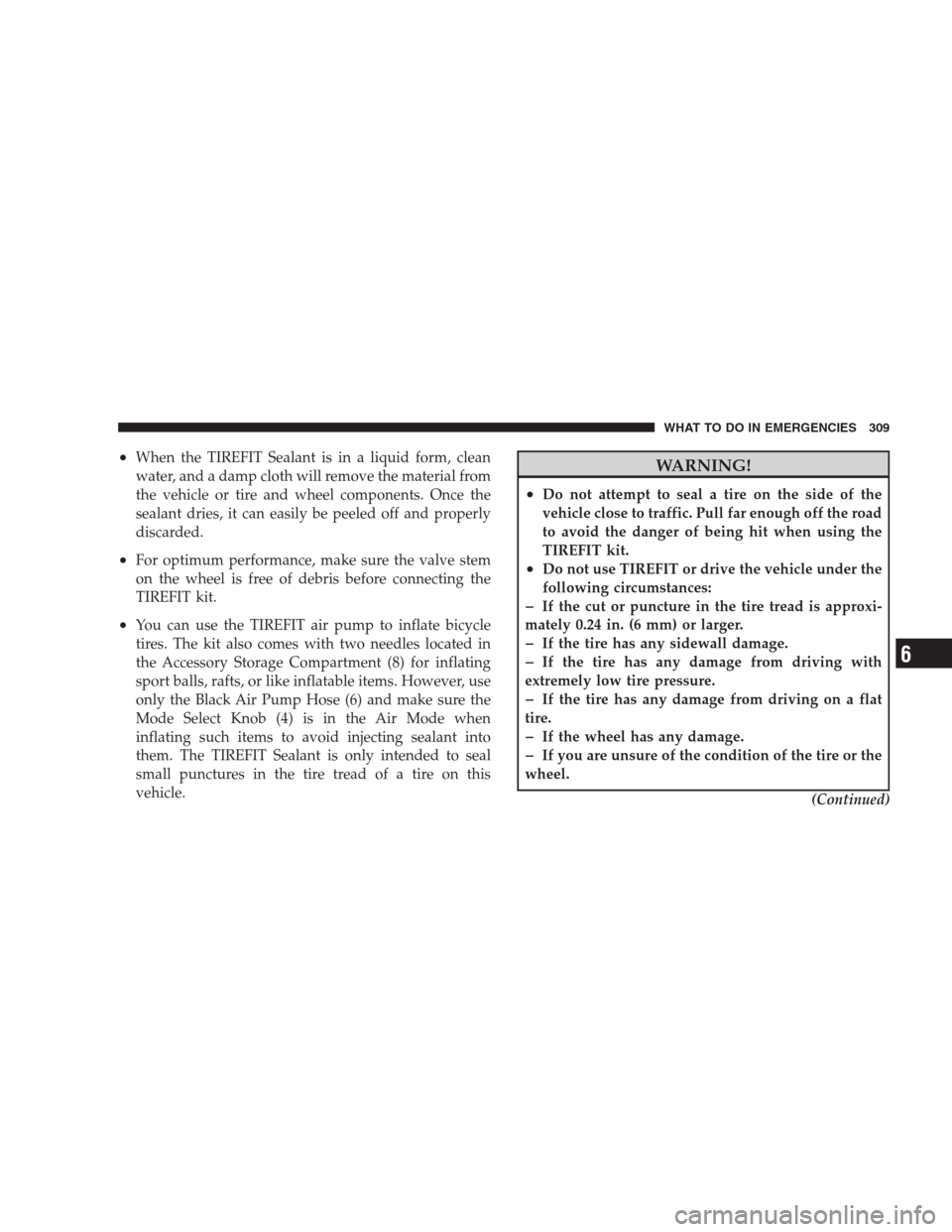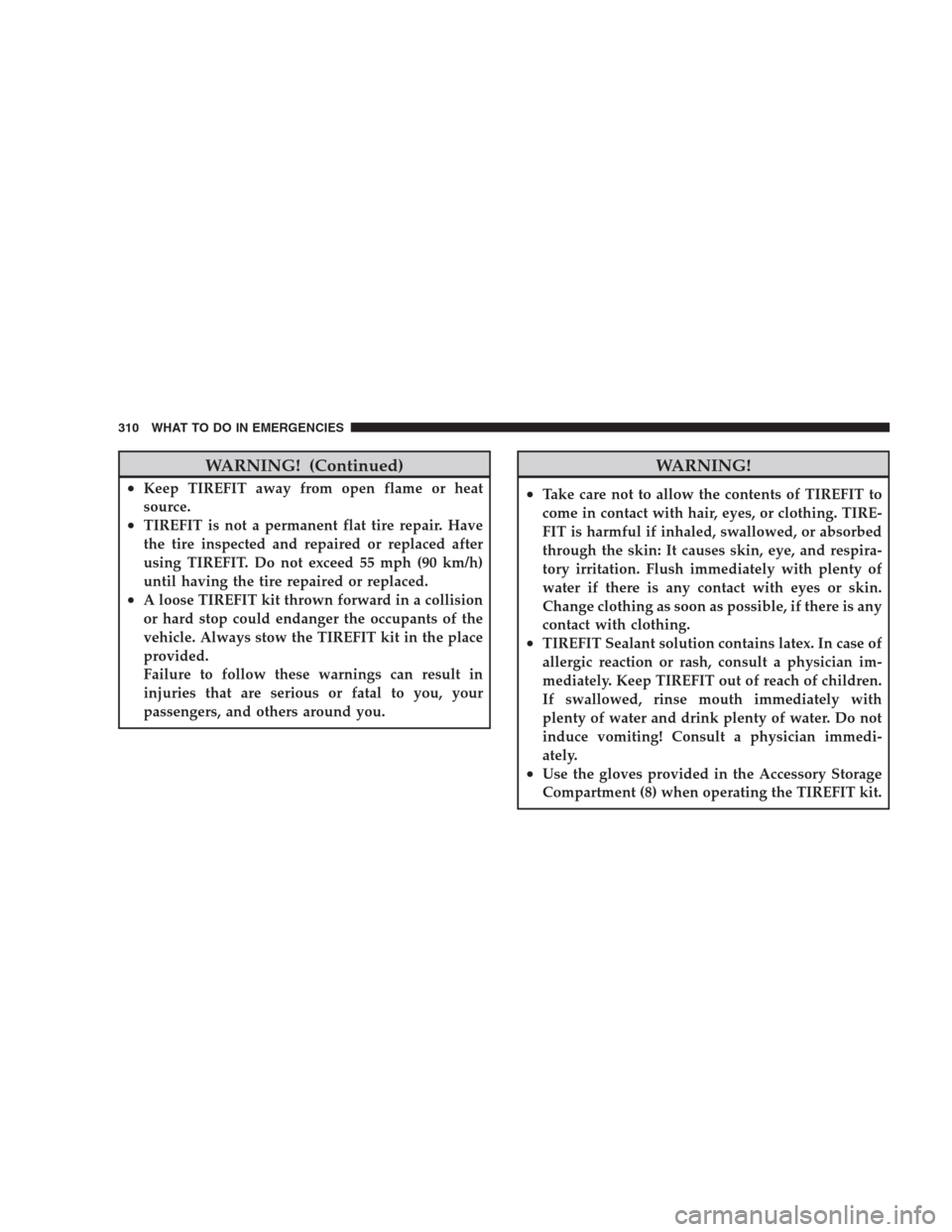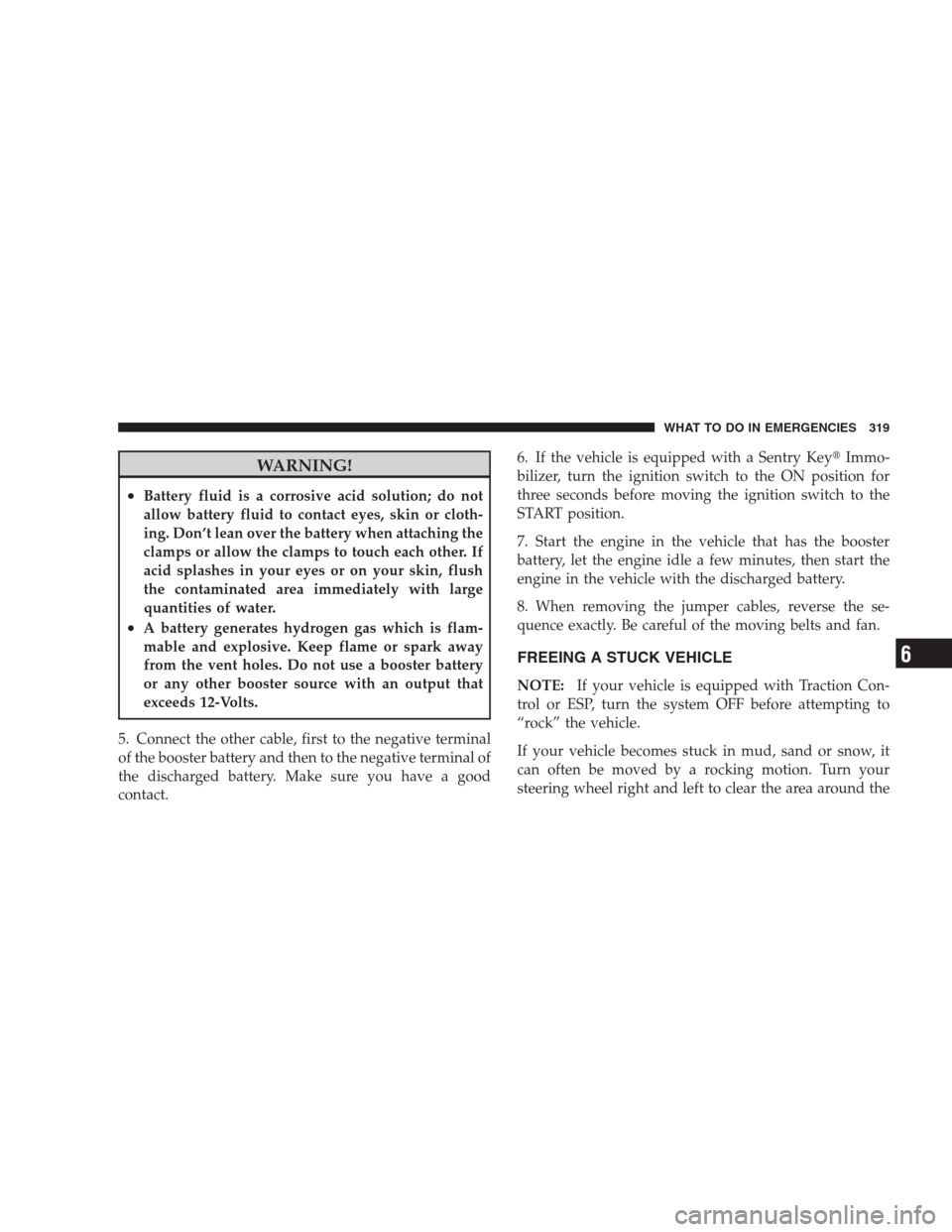Page 311 of 411

•When the TIREFIT Sealant is in a liquid form, clean
water, and a damp cloth will remove the material from
the vehicle or tire and wheel components. Once the
sealant dries, it can easily be peeled off and properly
discarded.
•For optimum performance, make sure the valve stem
on the wheel is free of debris before connecting the
TIREFIT kit.
•You can use the TIREFIT air pump to inflate bicycle
tires. The kit also comes with two needles located in
the Accessory Storage Compartment (8) for inflating
sport balls, rafts, or like inflatable items. However, use
only the Black Air Pump Hose (6) and make sure the
Mode Select Knob (4) is in the Air Mode when
inflating such items to avoid injecting sealant into
them. The TIREFIT Sealant is only intended to seal
small punctures in the tire tread of a tire on this
vehicle.
WARNING!
•Do not attempt to seal a tire on the side of the
vehicle close to traffic. Pull far enough off the road
to avoid the danger of being hit when using the
TIREFIT kit.
•Do not use TIREFIT or drive the vehicle under the
following circumstances:
�If the cut or puncture in the tire tread is approxi-
mately 0.24 in. (6 mm) or larger.
�If the tire has any sidewall damage.
�If the tire has any damage from driving with
extremely low tire pressure.
�If the tire has any damage from driving on a flat
tire.
�If the wheel has any damage.
�If you are unsure of the condition of the tire or the
wheel.
(Continued)
WHAT TO DO IN EMERGENCIES 309
6
Page 312 of 411

WARNING! (Continued)
•Keep TIREFIT away from open flame or heat
source.
•TIREFIT is not a permanent flat tire repair. Have
the tire inspected and repaired or replaced after
using TIREFIT. Do not exceed 55 mph (90 km/h)
until having the tire repaired or replaced.
•A loose TIREFIT kit thrown forward in a collision
or hard stop could endanger the occupants of the
vehicle. Always stow the TIREFIT kit in the place
provided.
Failure to follow these warnings can result in
injuries that are serious or fatal to you, your
passengers, and others around you.
WARNING!
•Take care not to allow the contents of TIREFIT to
come in contact with hair, eyes, or clothing. TIRE-
FIT is harmful if inhaled, swallowed, or absorbed
through the skin: It causes skin, eye, and respira-
tory irritation. Flush immediately with plenty of
water if there is any contact with eyes or skin.
Change clothing as soon as possible, if there is any
contact with clothing.
•TIREFIT Sealant solution contains latex. In case of
allergic reaction or rash, consult a physician im-
mediately. Keep TIREFIT out of reach of children.
If swallowed, rinse mouth immediately with
plenty of water and drink plenty of water. Do not
induce vomiting! Consult a physician immedi-
ately.
•Use the gloves provided in the Accessory Storage
Compartment (8) when operating the TIREFIT kit.
310 WHAT TO DO IN EMERGENCIES
Page 314 of 411

Using the Air Pump Power Button
Push and release the button (3) once to turn
ON the TIREFIT kit. Push and release the
button (3) again to turn OFF the TIREFIT kit.
Sealing a Tire with TIREFIT
(A) Whenever You Stop to Use TIREFIT:
1. Turn ON the vehicle’s hazard warning flashers.
2. Verify that the valve stem (on the wheel with the
deflated tire) is in a position that is near to the ground.
This will allow the TIREFIT Hoses (6) and (7) to reach the
valve stem and keep the TIREFIT kit flat on the ground.
This will provide the best positioning of the kit when
injecting the sealant into the deflated tire and running the
air pump. Move the vehicle as necessary to place the
valve stem in this position before proceeding.3. Place the transmission in PARK (auto transmission) or
in Gear (manual transmission) and turn OFF the ignition.
4. Set the parking brake.
(B) Setting Up to Use TIREFIT:
1. Remove the gloves from the Accessory Storage Com-
partment (8) and place them on your hands.
2. Turn the Mode Select knob (4) to the
Sealant/Air Mode position.
3. Uncoil the Clear Sealant Hose (7) and then remove the
Yellow Cap from the fitting at the end of the hose.
4. Place the TIREFIT kit flat on the ground next to the
deflated tire.
312 WHAT TO DO IN EMERGENCIES
Page 317 of 411

WARNING!
TIREFIT is not a permanent flat tire repair. Have the
tire inspected and repaired or replaced after using
TIREFIT. Do not exceed 55 mph (90 km/h) until
having the tire repaired or replaced. Failure to follow
this warning can result in injuries that are serious or
fatal to you, your passengers, and others around you.
(F) After Securing TIREFIT Sealant in the Tire:
1. Turn the Mode Select knob (4) to the Air
Mode position.
2. Uncoil the Black Air Pump Hose (6) and connect it to
the valve stem.
3. Check the pressure in the tire by reading the Pressure
Gauge (2).
•If the pressure is less than 19 psi (1.3 bar), the tire is
too badly damaged. Do not attempt to drive the
vehicle further. Call for assistance.
•If the pressure is equal to or greater than 19 psi
(1.3 bar), but less than the level indicated on the tire
pressure label, proceed to Step 4 of this procedure.
•If the pressure is at the level indicated on the tire
pressure label on the driver-side latch pillar, proceed
to Step 5 of this procedure.
4. Inflate the tire to the pressure indicated on the tire
pressure label on the driver-side latch pillar.
5. Disconnect the TIREFIT kit from the valve stem and
then reinstall the cap on the valve stem.
6. Place the TIREFIT kit in its proper storage area in the
vehicle.
WHAT TO DO IN EMERGENCIES 315
6
Page 319 of 411

(H) Sealant Bottle Replacement
1. Uncoil the Clear Sealant Hose (7).
2. Locate the rectangular SEALANT BOTTLE RELEASE
button in the recessed area where you place your fingers
to unlatch the hoses (6) (7) from their storage area.
3. Use the Yellow Cap on end of the Clear Sealant Hose
(7) to depress the SEALANT BOTTLE RELEASE button.
The Sealant Bottle (1) will pop up. Remove the bottle and
dispose of it accordingly.
4. Clean any remaining sealant from the TIREFIT hous-
ing.
5. Position the new Sealant Bottle (1) to the housing so
that the Clear Sealant Hose (7) aligns with the hose slot in
the front of the housing and the alignment keys on the
bottom of the bottle align with the alignment slots in thehousing. Then, press the bottle into the housing. An
audible click will be heard, indicating the bottle is locked
in place.
6. Verify the Yellow Cap is installed on the fitting at the
end of the Clear Sealant Hose (7) and return the hose to
its storage area.
7. Return the TIREFIT kit to its storage area in the
vehicle.
JUMP-STARTING PROCEDURES
WARNING!
•Take care to avoid the radiator cooling fan when-
ever the hood is raised. It can start anytime the
ignition switch is on. You can be hurt by the fan.
(Continued)
WHAT TO DO IN EMERGENCIES 317
6
Page 320 of 411

WARNING! (Continued)
•Do not attempt to push or tow your vehicle to get
it started. Vehicles equipped with an automatic
transaxle cannot be started this way and may be
damaged. Unburned fuel could enter the catalytic
converter and once the engine has started, ignite
and damage the converter and vehicle. If the
vehicle has a discharged battery, booster cables
may be used to obtain a start from another vehicle.
This type of start can be dangerous if done im-
properly, so follow this procedure carefully.
•Wear eye protection and remove any metal jewelry
such as watch bands or bracelets that might make
an inadvertent electrical contact. You could be
seriously injured.
NOTE: Disconnecting the battery with the ignition in
the ON position will cause vehicles with an automatictransaxle (CVT2) to go into “default mode” and turn on
the Malfunction Indicator Light (MIL). See your autho-
rized dealer to correct this condition.
1. When boosting from a battery in another vehicle, park
that vehicle within booster cable reach but without
letting the vehicles touch. Set the parking brake, place the
automatic transmission in PARK (the manual transmis-
sion in NEUTRAL) and turn the ignition to OFF for both
vehicles.
2. Turn off the heater, radio and all unnecessary electrical
loads.
3. Using the two finger screws on the cover, remove the
air intake duct covering the battery.
4. Connect one end of a jumper cable to the positive
terminal of the booster battery. Connect the other end of
the jumper cable to the positive terminal of the dis-
charged battery.
318 WHAT TO DO IN EMERGENCIES
Page 321 of 411

WARNING!
•Battery fluid is a corrosive acid solution; do not
allow battery fluid to contact eyes, skin or cloth-
ing. Don’t lean over the battery when attaching the
clamps or allow the clamps to touch each other. If
acid splashes in your eyes or on your skin, flush
the contaminated area immediately with large
quantities of water.
•A battery generates hydrogen gas which is flam-
mable and explosive. Keep flame or spark away
from the vent holes. Do not use a booster battery
or any other booster source with an output that
exceeds 12-Volts.
5. Connect the other cable, first to the negative terminal
of the booster battery and then to the negative terminal of
the discharged battery. Make sure you have a good
contact.6. If the vehicle is equipped with a Sentry Key�Immo-
bilizer, turn the ignition switch to the ON position for
three seconds before moving the ignition switch to the
START position.
7. Start the engine in the vehicle that has the booster
battery, let the engine idle a few minutes, then start the
engine in the vehicle with the discharged battery.
8. When removing the jumper cables, reverse the se-
quence exactly. Be careful of the moving belts and fan.
FREEING A STUCK VEHICLE
NOTE:If your vehicle is equipped with Traction Con-
trol or ESP, turn the system OFF before attempting to
“rock” the vehicle.
If your vehicle becomes stuck in mud, sand or snow, it
can often be moved by a rocking motion. Turn your
steering wheel right and left to clear the area around the
WHAT TO DO IN EMERGENCIES 319
6
Page 322 of 411

front wheels. Then shift back and forth between RE-
VERSE and 1st gear. Usually the least accelerator pedal
pressure to maintain the rocking motion without spin-
ning the wheels is most effective.
WARNING!
Fast spinning tires can be dangerous. Forces gener-
ated by excessive wheel speeds may cause axle, tire
damage or failure. A tire could explode and injure
someone. Do not spin your vehicle’s wheels faster
than 30 mph (48 km/h) or for longer than 30 seconds
continuously without stopping when you are stuck.
And don’t let anyone near a spinning wheel, no
matter what the speed.
CAUTION!
Racing the engine or spinning the wheels too fast
may lead to transaxle overheating and failure. It can
also damage the tires. Do not spin the wheels above
30 mph (48 km/h). Do not spin the wheels continu-
ously for more than 30 seconds.
TOWING A DISABLED VEHICLE
With Ignition Key
Automatic Transaxle
•
Front Wheel Drive (FWD) vehicles can be towed with
the front wheels elevated or on a flatbed truck (all four
wheels off the ground).
•All Wheel Drive (AWD) vehicles must be towed on a
flatbed truck (all four wheels off the ground).
320 WHAT TO DO IN EMERGENCIES